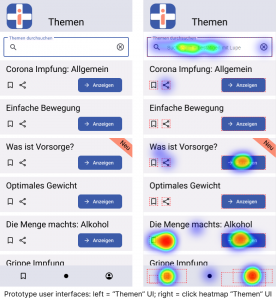Prototypical design and testing of a digital, mobile health service for raising awareness about disease prevention among apprentices
Aim and Research Question(s)
The aim of this thesis was to elaborate requirements for a digital health information service for apprentices, considering and evaluating their interests, the expertise of experts, and to develop a prototype in terms of usability.
- RQ1: What are general requirements for apprentices to use health information in a digital service?
- RQ2: What are functional and technical requirements for a digital health service focused on disease prevention to improve apprentices' health awareness?
- RQ3: How can a prototype for a digital, mobile health information service be developed that achieves good usability with test participants?
Background
Young people in Austria have lower health literacy compared to other countries in the European Union [1]. Moreover, studies show that the individual lifestyle factors of apprentices are significantly worse compared to students of the same age [2]. Since individual lifestyle factors can be influenced by higher health literacy [1], the target groups is interested in digital health services [3] and the limited number of available and suitable apps [4], it is appropriate to design a prototype.
Methods
A literature review was conducted on apprentices’ health challenges, digital solutions, as well as technical and functional requirements for a digital health information service. Based on the elaborate requirements, a prototype of a digital mobile health service for raising awareness was developed considering the "human-centered design" process. The prototype was tested in terms of usability with test participants in a qualitative method using several instruments. These include the evaluation of the recorded tests regarding time and task performance, motion analysis as well as the standardized system usability scale from Brooke [5].
Results and Discussion
The result is a list of ten requirements for a digital health information service and a clickable prototype developed from this list. The prototype is smartphone-based, uses personalization option, motivational elements like gamification and is considering the environment of the target group by integration of functions for sharing content on social media and an export option for proofs of success. The usability of the system was rated as good by seven participants (SUS = 78.6). Through the evaluation, another six areas for improvement were derived in terms of navigation and user motivation.
Conclusion
This work can serve as a basis for further research. It could be shown that a prototype for a digital health information service can be implemented in a userfriendly way for test participants.
References
[1] Kickbusch et al. (2016). [2] Felder-Puig et al. (2020). [3] Scherenberg & Liegmann (2018). [4] Lampert & Scherenberg (2021). [5] Brooke (1996).